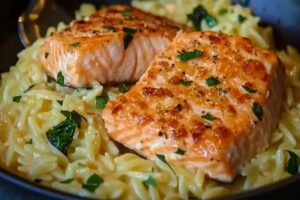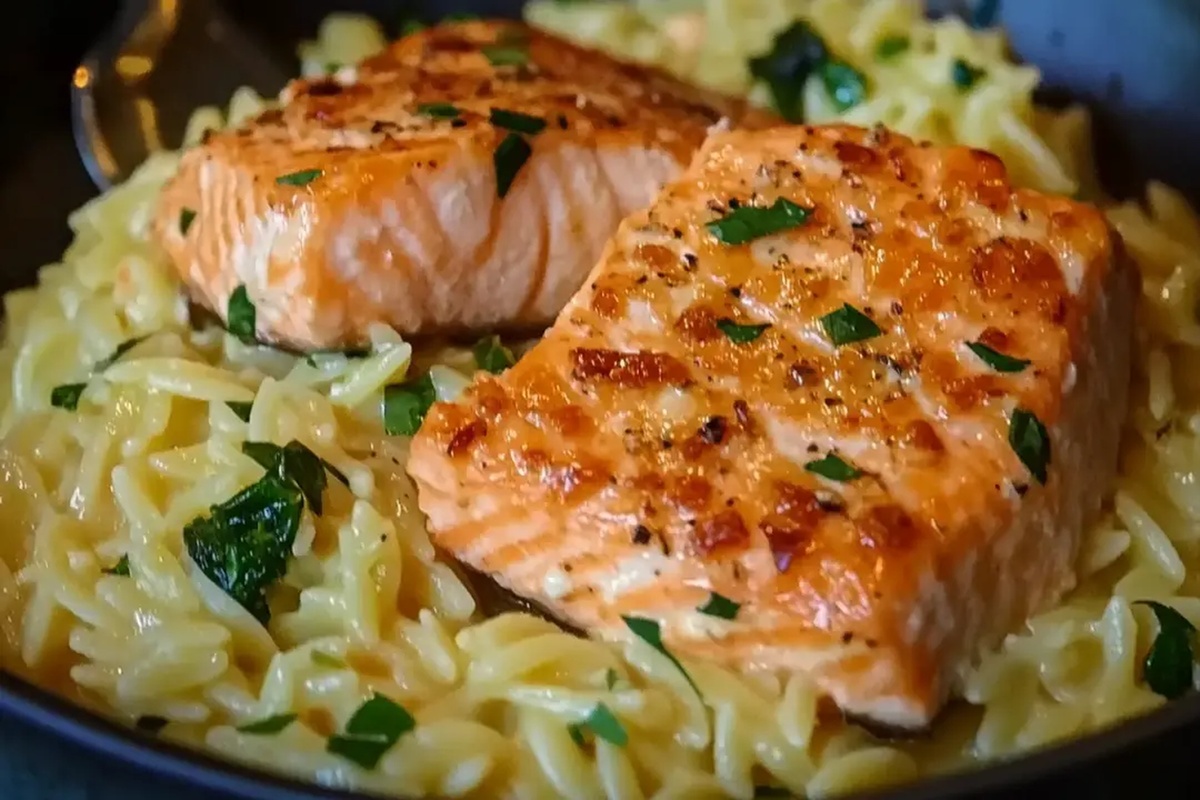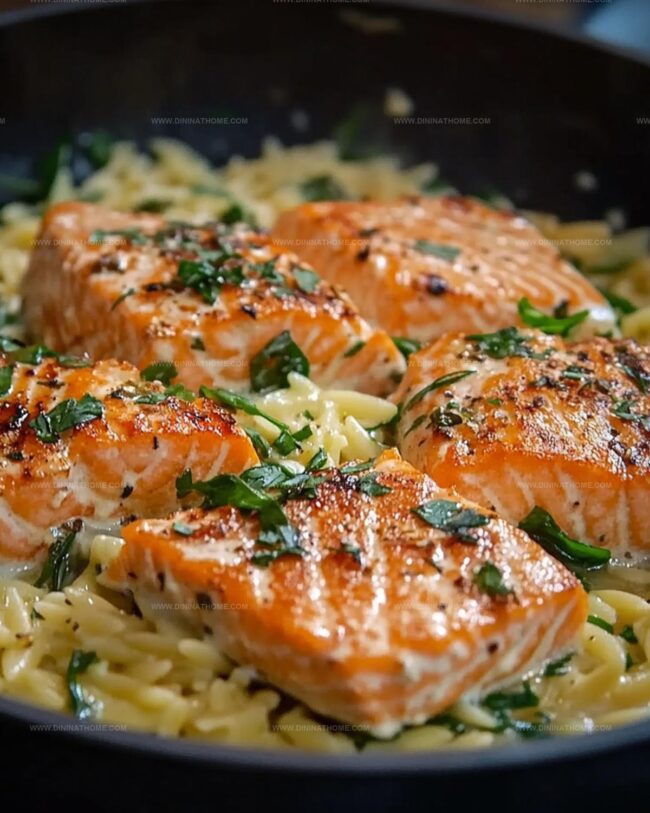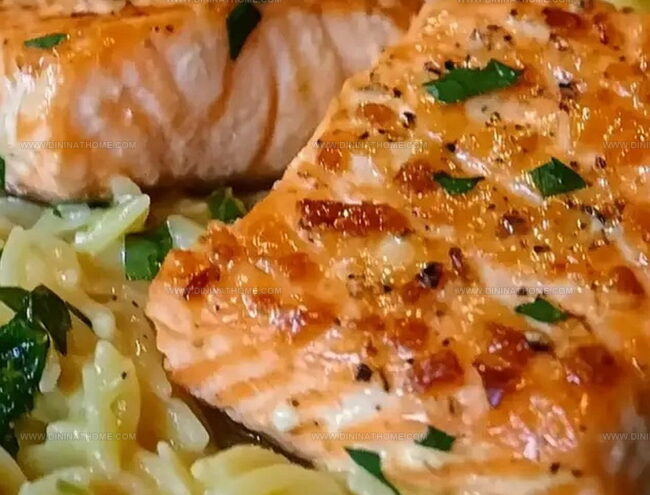Fresh and Flavorful Salmon and Orzo Dish Recipe
Culinary magic happens when a delectable salmon and orzo dish brings unexpected flavors to your dinner table.
Mediterranean influences dance through this elegant meal, creating a symphony of textures.
Home cooks find themselves enchanted by the simple yet sophisticated combination of tender fish and delicate pasta.
Fresh herbs and a light lemon touch make this recipe shine with vibrant character.
Each bite promises a delightful journey through rich, wholesome ingredients.
Coastal inspirations infuse every forkful with warmth and comfort.
Let this salmon and orzo adventure become your new weeknight favorite.
Salmon And Orzo Dish That Feels Fancy But Stays Simple
Inside the Salmon and Orzo Dish Recipe
Main Proteins:Aromatics and Seasonings:Cooking Liquids and Greens:Salmon and Orzo Dish Cooking Method
Step 1: Elevate the Salmon
Massage the salmon fillets with a blend of garlic powder, paprika, salt, and pepper, ensuring each side gets a generous coating of flavor.
Step 2: Craft the Orzo Base
Warm a large pan and sauté the onion and garlic until they become translucent and fragrant.
Toss in the orzo and let it dance and toast for a couple of minutes.
Pour in the broth, creating a steamy environment, then cover and let the orzo simmer until it becomes tender and absorbs all the liquid, which takes around 10-12 minutes.
Step 3: Sear the Seafood
Heat a pan and create a golden-brown crust on the salmon fillets.
Cook each side for 3-4 minutes, ensuring the fish is perfectly cooked through with a slight flakiness.
Step 4: Blend and Enhance
When the orzo reaches perfection, introduce fresh spinach, allowing it to wilt gently.
Sprinkle in dill and Parmesan, then brighten the entire dish with a zesty lemon squeeze.
Break the salmon into delicate pieces and fold it into the vibrant mixture.
Step 5: Present with Flair
Transfer the salmon and orzo creation to serving plates.
Crown the dish with additional dill and a sprinkle of Parmesan cheese for a restaurant-worthy presentation.
Salmon and Orzo Prep Tips That Impress
Reheat Salmon and Orzo Dish
What to Eat with Salmon and Orzo Dish
Salmon Orzo Dish Creative Edits
FAQs
Yes, you can substitute salmon with other fish like cod, halibut, or trout. Just make sure to adjust cooking times based on the thickness of the fish.
Not as written. Orzo is a type of pasta made from wheat, so it contains gluten. To make it gluten-free, replace orzo with quinoa or rice.
Salmon is done when it reaches an internal temperature of 145°F. The fish should be opaque and flake easily with a fork. Cooking time is typically 3-4 minutes per side.
It’s best served fresh. Orzo can become mushy if reheated, and salmon tends to lose its texture when prepared in advance. If needed, cook components separately and combine just before serving.
Print
Salmon And Orzo Dish Recipe
- Total Time: 30 minutes
- Yield: 2 1x
Description
Mediterranean salmon nestles atop herbed orzo, creating a luxurious plate that whisks palates to coastal Greece. Delicate fish mingles with aromatic herbs, inviting you to savor each Mediterranean-inspired bite.
Ingredients
Protein:
- 2 salmon fillets
Seasonings:
- 1 teaspoon garlic powder
- 1 teaspoon paprika
- Salt and pepper to taste
Vegetables and Aromatics:
- 1/2 onion, chopped
- 3 cloves garlic, minced
- 2 cups fresh spinach
- 1/4 cup fresh dill, chopped
Grains and Liquids:
- 1 cup dry orzo
- 3 cups broth (vegetable or chicken)
Cheese and Citrus:
- 1/2 cup grated Parmesan cheese
- 1 lemon, juiced
Instructions
- Prepare the salmon by generously coating both sides with a blend of aromatic spices, creating a flavorful exterior that will enhance the fish’s natural taste.
- Initialize the orzo cooking process by gently sautéing aromatic onions and garlic until they become translucent and fragrant, releasing their essential oils.
- Introduce the orzo to the pan, allowing it to toast briefly, which will develop a nutty undertone and add depth to the overall dish.
- Hydrate the orzo with warm broth, ensuring it simmers gently and absorbs the liquid completely, transforming into a creamy, tender base.
- While the orzo cooks, focus on preparing the salmon by searing it in a hot skillet, creating a golden-brown crust that locks in moisture and flavor.
- Once the orzo reaches the perfect consistency, elevate its profile by folding in vibrant spinach leaves, which will wilt and integrate seamlessly into the dish.
- Enhance the flavor profile with fresh dill and a sprinkle of Parmesan cheese, adding complexity and a subtle richness to the preparation.
- Drizzle fresh lemon juice over the mixture, providing a bright, citrusy note that cuts through the richness and balances the dish.
- Delicately break the salmon into rustic chunks and incorporate it into the orzo, allowing the fish to mingle with the herbs and grains.
- Present the dish on warm plates, garnishing with additional dill and a light dusting of Parmesan to create an visually appealing and appetizing final touch.
Notes
- Choose sustainable, wild-caught salmon for better flavor and nutrition.
- Pat salmon dry before seasoning to ensure crispy, golden-brown exterior when searing.
- Toast orzo briefly in pan to enhance nutty, rich flavor profile before adding liquid.
- Swap Parmesan for nutritional yeast to make dish dairy-free and vegan-friendly.
- Prep Time: 5 minutes
- Cook Time: 25 minutes
- Category: Lunch, Dinner
- Method: Sautéing
- Cuisine: Mediterranean
Nutrition
- Serving Size: 2
- Calories: 450
- Sugar: 2 g
- Sodium: 600 mg
- Fat: 20 g
- Saturated Fat: 7 g
- Unsaturated Fat: 10 g
- Trans Fat: 0 g
- Carbohydrates: 42 g
- Fiber: 3 g
- Protein: 30 g
- Cholesterol: 75 mg





James Walker
Lead Recipe Developer & Culinary Educator
Expertise
Southern Cuisine & Farm-to-Table Cooking, Recipe Development & Testing, Culinary Education & Instruction
Education
School: Auguste Escoffier School of Culinary Arts
Program: Diploma in Culinary Arts and Operations
Focus: Comprehensive training in classical and modern culinary techniques, kitchen operations, and farm-to-table practices.
James didn’t learn cooking from a TV show, he learned it from busy kitchens, family gatherings, and long afternoons spent testing recipes the hard way.
After training at the Auguste Escoffier School of Culinary Arts, he brought his love for real, down-to-earth food to every dish he makes.
At Dining At Home, James loves building recipes that feel familiar but still have something special, like adding a twist to a classic or making a slow Sunday dinner feel brand new.
When he’s not in the kitchen, you’ll probably find him swapping garden tips at the farmers’ market or teaching his daughter how to flip pancakes without a mess (almost).